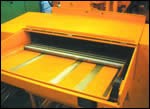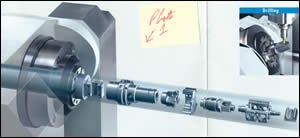Workholding Advantages Of Barstock
Barstock is versatile raw material. It’s easily held, easily fed and has significant capacity for many parts per bar. Usually we think of barstock and bar feeders in relation to turning machines. What about applying the advantages of automatically fed barstock to a vertical machining center?
One of the most intriguing aspects of metalworking is the many tools and methods at our disposal to process parts. Technology represents the science of manufacturing while the application of technology represents the art of manufacturing.
Every day, shops are presented with jobs that require the blending of science and art in an effort to take a lower value blank and add value through processing that blank. Making the best choices for how to process a part is the challenge.
Producing good parts, on time and at a profit, is the reward. At the end of the day, it is the shop that most consistently “gets it right” by finding the better way to make its customer’s parts and satisfy the customer’s needs that succeeds.
With the increasing flexibility, reliability and ease of use that electronics bring to the mechanical world of machine tools, many new ways of producing parts are becoming available at prices that are not through the roof. Automation created by the use of computer-based technology is enabling shops of all stripes to produce more parts of higher quality, tighter tolerances and on a more consistent basis then ever before.
These advantages are manifested in the drive to manufacture workpieces in a single part handling. Instead of performing specific operations on a machine and then passing the partially machined part to the next operation, multiple operations can be performed on a single machine tool platform, reducing work handling and the cost of production while increasing productivity.
We’ve all seen this single handling process in the form of turn-mill machines—some basic, using live tooling on a turret, and others more sophisticated with articulated machining center spindles mounted on a turning center frame. This article looks at multi-processing through a different lens. Think mill/turn.
An Interesting Idea
It only makes sense to apply the advantages of multiple operations enjoyed by turning center-based multi-processing machines to a machining center-based platform. The C-frame vertical machining center is versatile, cost effective and productive.
What it has historically lacked is an efficient method of workpiece delivery and removal. While the worktable of a conventional VMC can be fixtured to hold as many part blanks as the table size permits, it still is a batch production process that requires intervention once all the parts are machined. Moreover, the ability to process a part complete is hampered by a lack of access to all sides of the workpiece.
Basically, the idea behind a bar fed machining center is to take material handling and simplified fixturing advantages enjoyed by turning centers and apply them to a machining center. The application of a bar feeder to a VMC provides the ability to continuously supply the machines with blank material. Therefore, as long as the workpiece’s major dimension fits within the circumference of the bar, an unlimited variety of workpieces can be machined, including families of parts.
This workholding/handling marriage gives the machining center production capacity limited only to the amount of barstock that the feeder can hold. With the use of magazine loaders, this can be a significant amount of run capacity.
In addition, the use of barstock as a blank material eliminates the need for vises and fixtures and actually eliminates the conventional machining center worktable as well. All of the bar fed machining centers we’ve seen are five axis. However, there are several ways to approach the way the five-axes are applied.
We visited Chiron America (Charlotte, North Carolina) to find out more about this new class of machine tool technology. Through the company’s Chiron and Stamma lines, they have developed a successful line of bar fed machining centers.
How It Works
The machines that Chiron has developed for bar fed machining are purpose built. To the left side of the machining zone, where a conventional worktable would sit, is a headstock or bar handler. On the right side of the work zone is a receiver that acts like a pickoff spindle that allows for backworking operations, or when speaking of machining centers, allows for sixth-side machining.
This machine can accept any commercial bar feeder including short bar, 20-foot bar, single bar or magazine fed. The maximum through-hole for the model FZ 08K S Magnum is 32 mm.
The bar feed is aligned with the bed-mounted headstock, just like a turning center. This headstock uses an integral spindle motor capable of 8,000 rpm for turning. It is also under servo control for contouring operations from zero to 50 rpm.
In operation, the work is fed to a programmed length using the bar feeder. The machining spindle has four axes at the tool tip. The B axis on the spindle carrier is a swivel that traverses from minus 20 degrees through 115 degrees. It can access the workpiece fully from a vertical plane past a horizontal plane. The main spindle is serviced by a 40-tool-capacity automatic toolchanger with a 3-second tool change cycle. Both turning and milling tools are stored in this unit.
On a bed mounted secondary X axis, to the right of the machining zone, the sixth side manipulator can perform double duty as a pickoff for backworking, or it can be positioned for support of longer workpieces—functioning as a tailstock when needed to reduce part deflection.
After the machining is complete, the workpiece is cut off using a saw or cutoff tool, and if backworking is required, the bed-mounted manipulator secures the workpiece for cutoff and holds it for backworking operations. A discharge conveyor removes the completed part.
Chiron’s Stamma brand approaches the bar fed machining process a bit differently. It is designed for larger diameters—up to 65 mm through feed. Also a five-axis machine, it is configured with a conventional three-axis spindle carrier and uses a pivoting/rotating bar handler for the fourth and fifth axes (rotary A and B).
Because of this “headstock” configuration, barstock length is restricted to bars of 800 mm (32 inches) in length; therefore, a short feeder is specified. In operation the pivoting headstock/bar handler takes the full 32 inches of bar length from the feeder and machines parts from that length until the bar is used up.
A magazine feeds the next pre-cut bar so production is uninterrupted. Depending on the bar diameter, up 157 feet (48 meters) can be stored in a magazine. Like the Chiron, the Stamma is configured with a pickoff manipulator for backworking the part for six-sided, complete machining.
Why Consider A Bar Fed Machining Center?
It’s no secret that the manufacture of complex, high-precision parts is where much of the “action” is for precision parts manufacturers. Much of that work is in the manufacture of parts for the medical industry as well as aerospace and electronics.
Shops participating in these industries, especially medical, are enjoying good order levels. In many cases, these shops are looking for ways to do more work for active customers. This, of course, means increasing the shop’s production capability.
Many precision parts are successfully produced using turning-based technology. The versatility of a CNC Swiss-type comes to mind. However, for applications that require 50 percent or more milling operations, the bar fed machining center may make sense.
These machines are designed to augment the production primarily of turned parts (bone screws for medical as an example) with the ability to make prismatic and other complex parts that are better processed using more milling and less turning, such as bone plates.
For shops that are primarily built around turning operations, the best thing about bar fed machining centers is it dovetails into the shop’s existing infrastructure. There is no fixturing to figure out. If a shop already does turning work, it already has a supply of collets in house. If it’s using CNC Swiss or other CNC machine tools, programming this five-axis machine is probably less daunting than a seven- or 11-axis Swiss-type. A good supply of cutters is probably available in the toolroom as well.
The bottom line for looking at this technology is it brings the business an opportunity to do more for a good customer. If a company is already making a customer’s bone screws, why shouldn’t it try the bone plate business?
With fewer “live” customers, the shop that can do more for the customers they have, regardless of the industry served, is the shop that will move its business forward in spite of the changing nature of metalworking manufacturing.
Related Content
The Value of Swiss-Types Milling Rectangular Medical Parts
High-speed spindle technology was key to effective milling of small cardiac monitoring components complete on a CNC sliding-headstock machine platform instead of running them across two mills.
Read MoreMaking Micro Threads
Production of micro threads can be challenging, but using the most suitable tools for a given application can simplify the task.
Read MoreParting Off: The Case for Standardizing on Sawing
The value of rotary saw cutting for parting off operations could boil down to simple economics paired with process efficiency gains.
Read MoreAutomation Breakthroughs Revolutionize Precision Machining for Complex Parts
Marubeni Citizen-Cincom delivers custom solutions to address some of the biggest challenges in precision machining from handling small parts, to robot integration and unique tooling needs.
Read MoreRead Next
Workholding Collets And Factors That Affect Grip Force
The phenomenon of the staying power of the collet, in light of the rapidly changing technology in machine tool design, is attributed to the utility and the elegant simplicity of the device. The collet is a small but powerful component for the machine tool industry, incorporating all of the these features.
Read MoreEmerging Leaders Nominations Now Open
Here’s your chance to highlight a young person in your manufacturing business who is on the path to be a future leader moving your company forward.
Read MoreA Tooling Workshop Worth a Visit
Marubeni Citizen-Cincom’s tooling and accessory workshop offers a chance to learn more about ancillary devices that can boost machining efficiency and capability.
Read More















.jpg;maxWidth=300;quality=90)












